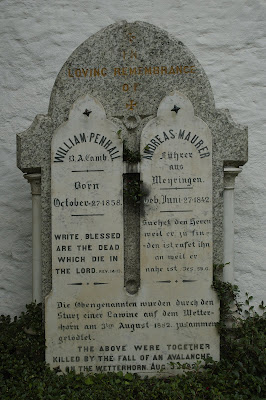
grave stone with rope and pick
rope and ice axes on a grave stone to show that someone had an accident while mountain climbing. But some Grave stone in the mountains, tells the story of heroism or of a lost love.
No mountaineer would be described as suicidal, but an accident in the Alps every year several hundred people kill. Since leading the DAV, SAC and PES statistics on the number of accidents in the mountains, is the number of fatal mountain accidents be fast. Although both the equipment has improved for most hikers and rescue equipment much, but the number of dead remains in the face of ever increasing difficulty of the routes and increasing popularity of alpine risk sports about the same.

So developing countries in the Alps its own iconography of death and mountain changed with the decades according to the changed consciousness. In Grindelwald and Zermatt, the cemetery is located next to the church and have provided an unobstructed view of the mountains, the victims here found their last resting place.
The Matterhorn looks menacingly over the church to the cemetery and Zermatt, Grindelwald offers a terrifying view of the cemetery in the gray-black Eiger North Wall, where 50 climbers have already have been killed. Many of them are in the immediate vicinity of the wall that has them is life.

are famous in Chamonix Bergsteiger neben unbekannten, es gibt dort eine ganze Abteilung, wo nur Bergsteiger zu liegen kommen. Die gesellschaftliche Bedeutung des Bergsteigens lässt sich so an Hand der Grabsteine aus verschiedenen Zeiten ablesen. Neben Namen und persönlichen Daten erwähnen viele Steine auch den Berg, wo der Begrabene den Tod gefunden hat. Im 19. Jahrhundert wurde der Tod in den Bergen mit romantischen Gedichten und Steinhauereien dargestellt. Auf dem Grab des Pfarrers zu Brighton, der 1841 am Schreckhorn den Tod fand, wird behauptet, dass es ohnehin besser sei, bei Christus im Himmel zu sein als auf der Erde. Jedes Zeitalter hat seine eigene Wahrnehmung und Interpretation des Todes, so wurde er denn auch lange Jahrzehnte mystifiziert. Mut und Treue wurden als männliche Virtues evoked and if the accident involved soldiers, which is found in Switzerland has always been, and always mention this specifically. Only the late 20th Century was characterized by an increasing objectification. But the insignia of the mountaineer, rope and ice axes, one can see on tombs from all periods.
The glaciers of the Mont Blanc mountain range are extremely rugged and have already given away dozens of victims again. Thus, a whole wall of the cemetery building in Chamonix with sheets of granite or marble in memory of climbers never found. Here plaques for known and unknown climbers from around the world hang together. Some tell of mountain adventures some call it simply the vital data. A grieving survivor said that his beautiful Valerie had married in 1990 with the mountain. Next to it is commemorated by a plaque on a young woman from Munich, the day after her 15th Birthday is an accident in a crevasse and whose body could not be salvaged.

climbers graves are graves of mostly young people who were torn from the full flower of her years and left a grieving family and many friends. Accordingly, they are often very individually, and for many years by parents and partners carefully maintained.
The top French alpinist Lionel Terray got in Chamonix as a kind of grave steinumrundeten alpine garden, and stands on a wooden table next to a martial pimples his name and that of his wife who died much later. He was involved in the first expedition, in which an eight-thousand was reached. Not far away is the grave of one of the most famous and most controversial climber of all time: The English artist and writer Edward Whymper was the first man on the Matterhorn and is a result of the tragedy that had overtaken the group on the descent, achieved lifelong negative publicity. He was accused, the rope on which hung the fallen four comrades, have been cut in order to save themselves. Proved the allegation but was nie. Eine verwitterte Marmortafel erinnert 98 Jahre nach seinem Tod in Chamonix an ihn.
Bergführer nehmen nicht nur in den Bergen eine Sonderstellung ein. Der Beruf gilt in den Berggebieten als eine besondere Auszeichnung, braucht er doch einen besonderen Mut und grosse Besonnenheit. Ohne diese Tugenden lebt es sich in den Bergen gefährlich. Bergführer nehmen auch auf den Friedhöfen eine Art Sonderstellung ein. Stirbt einer von ihnen bei der Ausübung seines gefährlichen Berufs, so tragen ihn die Bergführerkollegen zu Grabe. Auf dem Stein wird in jedem Fall die Berufsbezeichnung „Bergführer“ angegeben, auch wenn einer im hohen Alter im Bett gestorben ist.

0 comments:
Post a Comment